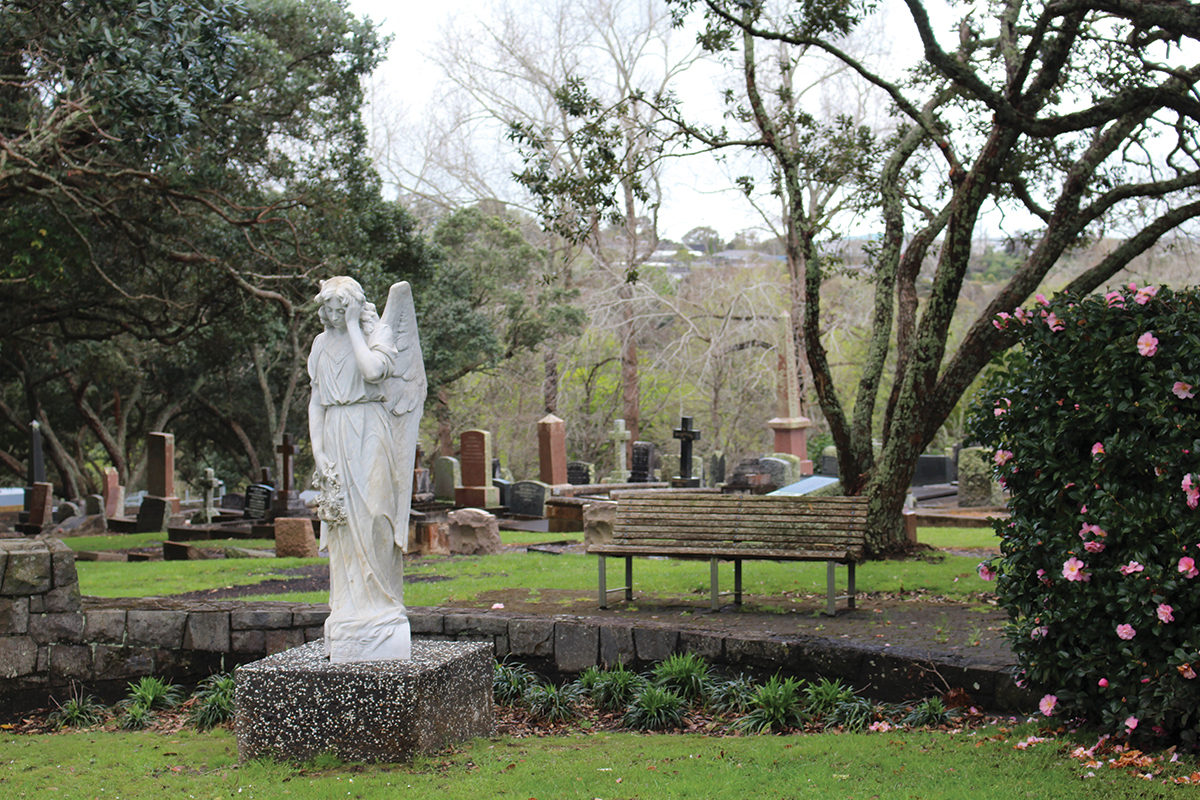Framed by the silvery, twisted limbs of pōhutukawa that intertwine overhead to form a canopy akin to an inverted cradle, the drive into Purewa is heavenly.
Dappled sunlight adds to the ethereal effect, a fitting entrance to one of Aotearoa’s grandest cemeteries, a thoroughfare directly into a Garden of Eden.
Residential homes dot the 3km perimeter, their gardens facing historic grey tombstones that emerge from undulating, pristine green lands sprinkled with colourful blooms and guarded by hundreds of handsome native trees that hum with birdsong and occasionally give way to sprawling views of Auckland. Benches are deliberately positioned for moments of reflection. There are even walking tracks. There is a definite sense of community, strange as that may be to say about a cemetery – but this is no ordinary cemetery. There is an aura to Purewa, the final resting place of some of New Zealand’s most important and impressive figures, in the Pourewa Valley in Auckland’s eastern suburbs.
“People do use this as a community park, which we love,” Purewa general manager, Alastair Crombie, tells Verve. “People jog here, walk their dogs, and even have picnics on the grass. We want to provide that space for people to meet and to remember. It’s a role we take very seriously.”
Alastair tells of a mother, Miriama, who started a wildflower planting programme following the death of her teenage son. What began as a personal project to help process her grief blossomed into an ongoing community project. “It was in an older part of the cemetery and many of the graves were no longer visited,” recalls Alastair, “so she started a volunteer group from the local community who came in to plant more wildflowers. They continue to visit a few times a week.”
Further community relationships have been built with local schools, retirement villages and Probus Clubs. A walk- and cycleway that connects the eastern suburbs to the CBD skirts the edge of the cemetery, and there are plans to open a portal to that too. “We just want to be as inclusive and welcoming as possible,” adds Alastair.
Alastair made his “random career change” later in life, having previously travelled the world making documentaries for the BBC and various other organisations. It was work that regularly took him to remote villages in Africa, “getting ushered into little huts, being offered a drink and something to eat – you can’t understand each other, but you create a connection”. Personable skills that are transferable to his current role. “We would find scenarios and tell stories,” Alastair says. “And we tell a lot of stories here.”
Purewa, established in 1889, is described as an “open air museum” that serves to preserve the memories of national leaders, military figures, artists, and entertainers. Well-known names include the businesswoman and philanthropist Marianne Smith-Caughey, founder of the department store Smith & Caughey’s; Maurice Paykel, co-founder of Fisher and Paykel; and New Zealand’s 31st prime minister, Sir Robert Muldoon. Lesser known, but equally remarkable “notables” include that of Walter Batty, the first Tongan All Black and hero of the second world war who earned the Distinguished Conduct Medal (DCM) for his single-handed combat against German tanks.
But Purewa looks to embrace its future as much as it honours its proud past. Walks along its memory lanes can be complemented by its website and smartphone app, offering interactive maps, video and narration by the playwright Sir Roger Hall and the poet and actor Peter Bland. Digital tours of notable graves include Courageous Women and the upcoming Theatre, Artists and Writers tour. In the works are also digital memorials, which will allow families to visit a certain site or station and sign into their smartphone or tablet to access their loves one’s story. “They could go to a plaque or beneath a tree to sit and reminisce and reflect,” says Alastair. State-of-the-art tech is accompanied by equally modern facilities including recently refurbished chapels and reception lounges, with both catering and streaming services also offered.
Alastair believes it a privilege to aid families through some of their darkest days. Both he – and the volunteer-run board – take pride in their roles as “custodians” of these historic grounds.
“It’s just such a special place, so well put together and in harmony with nature,” he says. “Just the other day someone commented about how beautiful it is, and how thankful they were that their loved one is buried here.”

Choices of Final Rest
“Services are certainly becoming more creative and celebratory,” says Alastair. “We’ve had Scottish pipers and horse-drawn carriages – we can accommodate pretty much any idea.”
Purewa also offers the country’s largest range of options for burials, cremations, and memorials. As well as traditional and natural burial plots, these include:
- Ash Berms positioned in open lawn spaces in the shade of mature trees. Plots can hold two sets of ashes, with space for plants and plaques.
- The scenic Walk of Memories, designed to accommodate up to two sets of ashes accompanied by tablets or plaques, that will eventually wind around the entire perimeter of the grounds.
- The Small Headstone Ash Lawn, spread across a suntrap and surrounded by trees. Two sets of ashes can be interred beneath the headstones.
- The Columbarium, an above- or in-ground memorial that houses ashes. An idea that dates back to the Romans, columbaria are an especially environmentally responsible, space-saving option.
- The Kidney Gardens, among Purewa’s most popular options with good reason owing to their vibrant flowers around a central cherry tree. With space for ash interments and plaques.
- The Mosaic Butterfly Pathway, designed by artist Joy Bell, allows for parents to place colourful ceramic tiles in memory of their lost babies on a pathway that circles an old oak tree.






